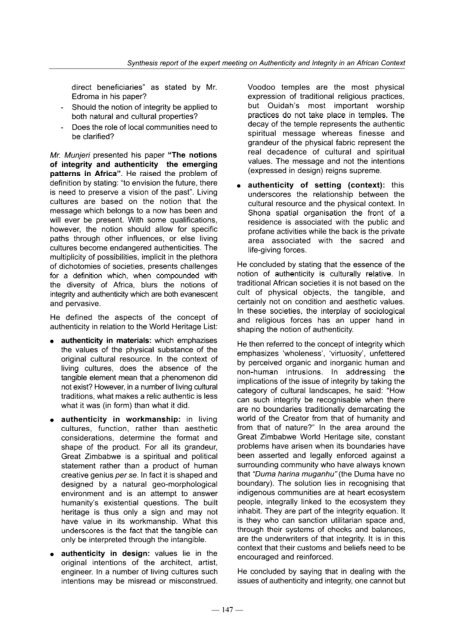Mul - unesdoc - Unesco
Mul - unesdoc - Unesco
Mul - unesdoc - Unesco
Create successful ePaper yourself
Turn your PDF publications into a flip-book with our unique Google optimized e-Paper software.
Synthesis report of the expert meetina on Authenticitv and Intearitv in an African Context<br />
, ” 2<br />
direct beneficiaries” as stated by Mr.<br />
Edroma in his paper?<br />
- Should the notion of integrity be applied to<br />
both natural and cultural properties?<br />
- Does the role of local communities need to<br />
be clarified?<br />
Mr. Munjeri presented his paper “The notions<br />
of integrity and authenticity the emerging<br />
patterns in Africa”. He raised the problem of<br />
definition by stating: “to envision the future, there<br />
is need to preserve a vision of the past”. Living<br />
cultures are based on the notion that the<br />
message which belongs to a now has been and<br />
Will ever be present. With some qualifications,<br />
however, the notion should allow for specific<br />
paths through other influences, or else living<br />
cultures become endangered authenticities. The<br />
multiplicity of possibilities, implicit in the plethora<br />
of dichotomies of societies, presents challenges<br />
for a definition which, when compounded with<br />
the diversity of Africa, blurs the notions of<br />
integrity and authenticity which are both evanescent<br />
and pervasive.<br />
He defined the aspects of the concept of<br />
authenticity in relation to the World Heritage List:<br />
authenticity in materials: which emphazises<br />
the values of the physical substance of the<br />
original cultural resource. In the context of<br />
living cultures, does the absence of the<br />
tangible element mean that a phenomenon did<br />
not exist? However, in a number of living cultural<br />
traditions, what makes a relit authentic is less<br />
what it was (in form) than what it did.<br />
authenticity in workmanship: in living<br />
cultures, function, rather than aesthetic<br />
considerations, determine the format and<br />
shape of the product. For all its grandeur,<br />
Great Zimbabwe is a spiritual and political<br />
statement rather than a product of human<br />
creative genius per se. In fact it is shaped and<br />
designed by a natural geo-morphological<br />
environment and is an attempt to answer<br />
humanity’s existential questions. The built<br />
heritage is thus only a sign and may not<br />
have value in its workmanship. What this<br />
underscores is the fact that the tangible cari<br />
only be interpreted through the intangible.<br />
authenticity in design: values lie in the<br />
original intentions of the architect, artist,<br />
engineer. In a number of living cultures such<br />
intentions may be misread or misconstrued.<br />
-147-<br />
Voodoo temples are the most physical<br />
expression of traditional religious practices,<br />
but Ouidah’s most important worship<br />
practices do not take place in temples. The<br />
decay of the temple represents the authentic<br />
spiritual message whereas finesse and<br />
grandeur of the physical fabric represent the<br />
real decadence of cultural and spiritual<br />
values. The message and not the intentions<br />
(expressed in design) reigns supreme.<br />
l authenticity of setting (context): this<br />
underscores the relationship between the<br />
cultural resource and the physical context. In<br />
Shona spatial organisation the front of a<br />
residence is associated with the public and<br />
profane activities while the back is the private<br />
area associated with the sacred and<br />
life-giving forces.<br />
He concluded by stating that the essence of the<br />
notion of authenticity is culturally relative. In<br />
traditional African societies it is not based on the<br />
cuit of physical abjects, the tangible, and<br />
certainly not on condition and aesthetic values.<br />
In these societies, the interplay of sociological<br />
and religious forces has an Upper hand in<br />
shaping the notion of authenticity.<br />
He then referred to the concept of integrity which<br />
emphasizes ‘wholeness’, ‘virtuosity’, unfettered<br />
by perceived organic and inorganic human and<br />
non-human intrusions. In addressing the<br />
implications of the issue of integrity by taking the<br />
category of cultural landscapes, he said: “How<br />
cari such integrity be recognisable when there<br />
are no boundaries traditionally demarcating the<br />
world of the Creator from that of humanity and<br />
from that of nature?” In the area around the<br />
Great Zimbabwe World Heritage site, constant<br />
problems have arisen when its boundaries have<br />
been asserted and legally enforced against a<br />
surrounding community who have always known<br />
that “Duma harina muganhu”(the Duma have no<br />
boundary). The solution lies in recognising that<br />
indigenous communities are at hear-t ecosystem<br />
people, integrally linked to the ecosystem they<br />
inhabit. They are part of the integrity equation. It<br />
is they who cari sanction utilitarian space and,<br />
through their systems of checks and balances,<br />
are the underwriters of that integrity. It is in this<br />
context that their customs and beliefs need to be<br />
encouraged and reinforced.<br />
He concluded by saying that in dealing with the<br />
issues of authenticity and integrity, one cannot but

















